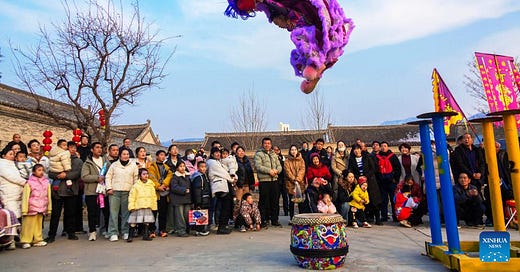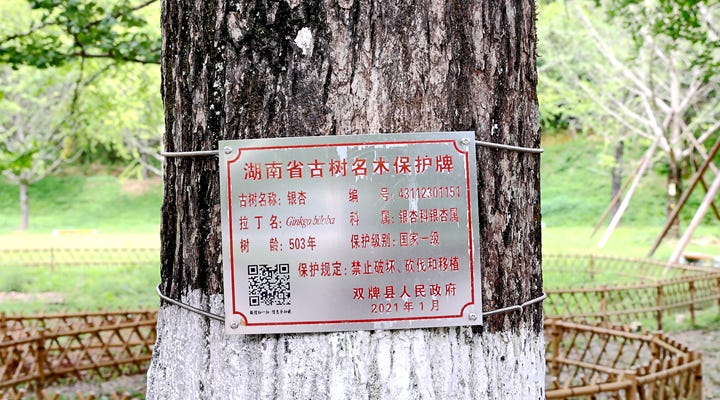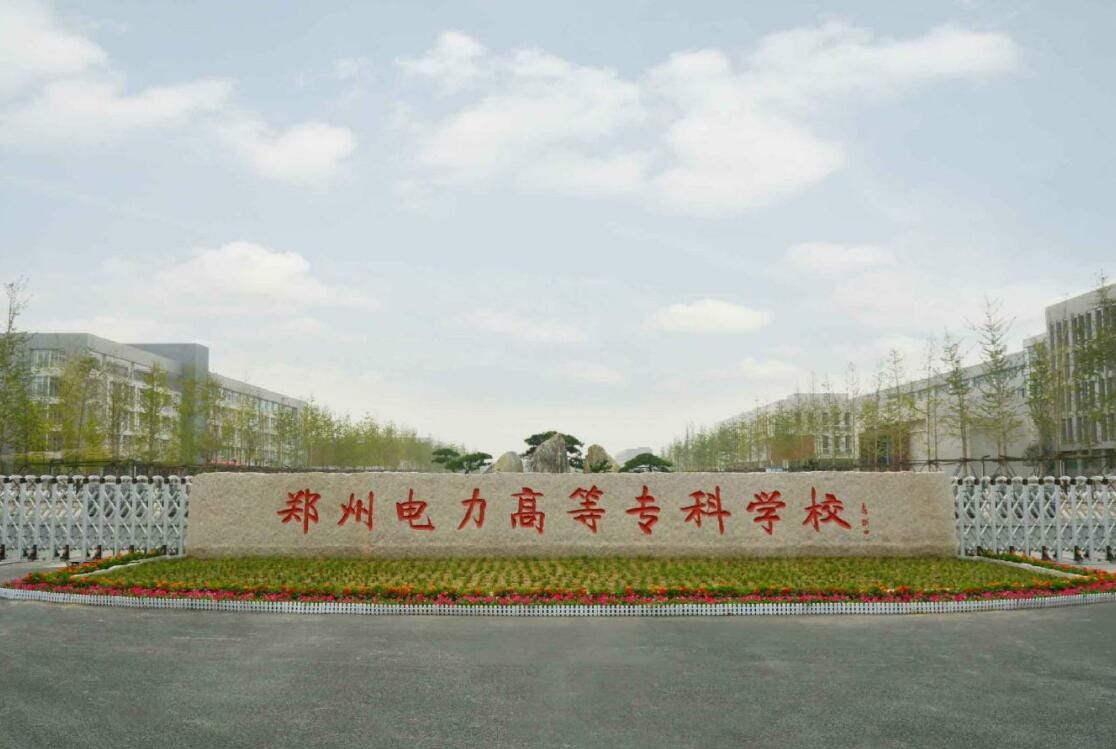The Harvest: This Week in Rural China – Dispatch No. 8 (6 February 2025)
Exploring China’s New Tree Protection Law, Henan’s Vocational Education Reforms, and the Role of Music in Rural Revitalisation.
Welcome to this week’s edition of The Harvest. After a brief break for the Chinese New Year holiday, we’re back with fresh insights into rural China’s evolving landscape.
This week, we focus on several key developments shaping the country’s future:
China’s New Tree Protection Law: We explore the recently introduced “Regulations on the Protection of Ancient and Notable Trees,” which will take effect in March 2025, and what it means for ecological preservation and cultural heritage.
Henan’s Vocational Education Reform: We delve into how Henan’s approach to vocational education reshapes rural economies, aligning local workers with the needs of growing industries while preserving their cultural identity.
Rural Revitalisation Through Music: The case of Lianfeng in Zhejiang province highlights how music and creative industries drive economic growth and cultural transformation in rural China.
As always, we’d love to hear your thoughts—feel free to reach out at nathan@thisweekinruralchina.com.
We hope this edition provides valuable perspectives on the dynamics shaping rural China.
China’s New Tree Protection Law: A Commitment to Cultural Heritage and Ecological Preservation
In a significant move to protect the nation’s environmental and cultural heritage, the State Council has officially announced the “Regulations on the Protection of Ancient and Notable Trees” (古树名木保护条例), which will take effect on 15 March 2025. This sweeping legislation signals China’s growing—if selective—commitment to environmental stewardship and preserving its natural legacy, particularly as it faces mounting ecological challenges.
A New Phase in China’s Conservation Policy
For those monitoring China’s evolving environmental policies, this regulation offers crucial insight into the country’s priorities regarding ecological conservation. The new law emphasises the preservation of trees that are not only ecologically significant but also hold deep cultural, historical, or scientific value—core elements of China’s rapidly evolving environmental policy.
The regulation introduces a formalised framework for identifying, cataloguing, and protecting trees over 100 years old, categorised as either “ancient trees” (古树, trees at least 100 years old, though a relatively low threshold compared to societies with a deeper tradition of ecological harmony) or “notable trees” (名木, those of cultural, historical, or scientific importance). Under the law, these trees receive varying degrees of protection based on age, with primary protection granted to those over 500 years old, secondary protection for those over 300 years old, and tertiary protection for trees over 100 years old.
Comparative Context: How Does China Measure Up?
China’s approach to ancient tree conservation has historically lagged behind some East Asian nations. In contrast, Japan has venerated sacred trees, often tied to Shinto shrines, for over a millennium, with protection ensured through deeply embedded cultural traditions. South Korea has integrated tree conservation within its broader forest management policies, with efforts dating back to the establishment of the Korean Forest Service in 1949 and the National Forest Conservation Act (1991), strengthening protections for sacred groves and ancient trees. Similarly, India’s preservation of sacred groves, particularly in the Himalayas and Rajasthan, reflects a blend of community-driven conservation and national legislation, such as the Forest Conservation Act (1980) and the National Biodiversity Action Plan (2008).
While China’s new law seeks to establish a more systematic approach to tree protection, it remains a state-driven initiative, reinforcing central authority over local landscapes—a recurring theme in environmental governance under Xi Jinping’s push for ecological civilisation (生态文明). This raises questions about enforcement. Historically, local government priorities have often undermined China’s environmental policies, particularly in areas where economic growth trumps ecological concerns. The effectiveness of this regulation will hinge on its implementation at the local level, where economic pressures and development interests frequently clash with conservation goals.
Implementation Challenges: Can the Law Hold?
One of the regulation’s most notable aspects is its decentralised management structure. While the State Forestry and Grassland Administration provides national oversight, the law mandates that local governments implement protection measures within their regions. This could be a strength and a weakness: localised governance allows for tailored conservation efforts, but enforcement risks are uneven, particularly in rural areas where economic incentives may encourage neglect or circumvention of regulations.
China’s new regulations on ancient tree protection signal an increasing awareness of its role in the global ecological movement. By incorporating legal mechanisms and community involvement, China takes a comprehensive approach to preserving its natural heritage. However, questions remain: will this be a turning point in China’s environmental governance, or will it face the same fate as past conservation laws—strong on paper but weak in enforcement? The effectiveness of this regulation will ultimately depend on its implementation at the local level, where economic pressures and development interests frequently clash with conservation goals.
Henan’s Vocational Education Reform: A Blueprint for Rural Economic Transformation
Henan’s vocational education reforms provide a compelling model for rural China’s shift from agriculture to industry. Once reliant on farming, Henan now looks to vocational education as a key strategy for aligning its workforce with the needs of growing industries. The province’s approach reflects a broader trend in rural China, where the goal is not to push people away from their agricultural roots but to empower them to thrive within their communities, contributing to modernisation while maintaining their cultural identity.
Henan’s vocational system, with over 750 institutions and nearly 3 million students, is designed to meet the demands of the region’s most important industries. The ‘7+28+N’ industrial chain model (‘7+28+N’产业链模式) connects seven primary sectors, 28 secondary industries, and many additional supporting sectors. This structure ensures that vocational education is closely aligned with local industry needs, equipping students with skills that support regional economic growth.
Rather than promoting the idea of leaving rural life behind, Henan’s reforms challenge the assumption that industrialisation requires an exodus from the countryside. The ‘Yu Pai Gong Fang’ (豫派工坊) craftsman brand exemplifies this, celebrating skilled labour in key sectors like energy, new manufacturing, and green technology while preserving traditional craftsmanship. Vocational education in Henan is not just about creating a skilled workforce but ensuring that rural populations remain integral to the region’s evolving economy.
A prime example is Zhengzhou Electric Power College (郑州电力高等专科学校), where thousands of workers have been trained to meet the growing demands of Henan’s energy sector. These initiatives highlight the value of keeping skilled workers within rural areas, ensuring they help drive local and national economic development without abandoning their communities.
While Henan’s vocational education reforms are a significant step towards aligning rural skills with industrial needs, the long-term effects of closely linking rural economic development to industrialisation warrant further examination; while this model may enhance employment opportunities and economic growth, it also raises questions about the impact on local cultural traditions and self-sufficiency. As rural areas integrate more closely with urban industries, there is a risk that a broader push towards industrialisation could overshadow these communities’ unique social structures and lifestyles.
This shift highlights a key challenge: how can rural areas benefit from industrial growth without compromising their inherent cultural identity and economic autonomy? When integrated with the needs of local communities, vocational education can play a vital role in fostering resilience, but it is crucial that this development remains balanced. It is important that vocational training serves industrial sectors and contributes to the broader goal of sustainable rural development, supporting both economic growth and preserving rural ways of life.
In this context, Henan’s vocational education model presents opportunities and challenges for rural regions across China. As the province continues to adapt its educational framework to meet local industrial needs, it may serve as an example of how rural economies can participate in broader national growth without losing their cultural and social foundations. Ensuring this balance will be essential for fostering sustainable and inclusive development in rural areas.
The Sound of Rural Revitalisation: Music as a Catalyst for Cultural and Economic Transformation in Rural China
This week, state media brought attention to the transformation of Lianfeng, a rural village in Zhejiang province led by musician Jin Wenkai. Through a blend of music, creative industries, and cultural tourism, Lianfeng has become a case study for China’s push to revitalise its rural areas. Jin’s venture, which includes the establishment of the Wangxiangli Music Art Space and a series of music workshops, is drawing significant attention locally and nationally as an example of how creative sectors can drive rural economic growth. The narrative presented in state media casts this initiative as emblematic of the broader national agenda of integrating rural communities into the global cultural economy.
Lianfeng’s project is certainly unique within the context of rural China, where traditional agricultural industries have long been the backbone of local economies. What sets it apart, however, is its focus on cultural and creative industries—sectors that have not traditionally been central to rural revitalisation strategies. Jin’s project, which draws on his background at the Shanghai Conservatory of Music, exemplifies how cultural tourism and music can attract visitors, bolster local employment, and create a new economic ecosystem. During the 2025 Spring Festival, Lianfeng’s music events brought over 11,000 participants, generating an estimated 1.1 million yuan in tourism-related revenue.
The coverage of Lianfeng in state media signals a clear push by the Chinese government to present rural revitalisation as a matter of agricultural transformation and cultural and economic diversification. However, the emphasis placed on such initiatives raises important questions. On the one hand, projects like Jin Wenkai’s are a promising illustration of the potential for rural communities to engage in global cultural trends and create new pathways for growth. Integrating creative industries into the rural economy can diversify income sources and attract domestic and international attention, offering a refreshing alternative to traditional agricultural reliance.
However, the framing of this success story by state media serves a specific narrative that aligns with China’s broader goals of rural rejuvenation and urban-rural integration. State outlets like Xinhua and People’s Daily have championed creative industries as integral to China’s future, with rural areas positioned as both beneficiaries and contributors to national development. While these projects present a degree of innovation, how they are presented can sometimes obscure the underlying motivations. By highlighting the successes of specific projects, the state media may seek to create an image of rural China as dynamic, progressive, and integral to the nation’s broader economic and cultural strategies.
This emphasis on cultural projects also risks oversimplifying the challenges rural areas face. While initiatives like Lianfeng’s are laudable in their creative approach, the broader picture of rural China’s development is much more complex. The state media narrative often centres on the idea that rural areas must adapt to urban models of growth—be it through industrialisation, service sectors, or, in this case, cultural tourism. However, such an approach may overlook the importance of preserving rural identity, self-sufficiency, and local traditions. The increasing focus on tourism and creative industries in the rural sector can sometimes mask the deeper struggles of rural communities, such as demographic decline, migration to urban centres, and the pressures of market-driven economic policies.
Lianfeng’s transformation presents an important test case. On one hand, it is a model of how creative industries can foster rural economic resilience, creating new spaces for cultural exchange and financial growth. On the other, it reflects the Chinese government’s ongoing efforts to steer rural revitalisation in a direction that increasingly mirrors urban consumer culture. Whether this model and others like it, will be sustainable in the long term is uncertain. While cultural tourism may bring short-term economic benefits, there is a question as to whether such models can fully replace the rural life that many villagers once led—connected to the land, agriculture, and locally sustained economies.
State Media Coverage of Chinese New Year in Rural China: A Review
During the Chinese New Year celebrations 2025, state media offered an in-depth portrayal of rural China, blending depictions of cultural vibrancy with ongoing efforts to modernise the countryside. This coverage highlighted a nuanced relationship between tradition, state-led development, and the future of rural life in an era of rapid change.
Cultural Celebrations and State Influence
State media focused heavily on rural New Year traditions as a cornerstone of Chinese cultural heritage. Reports frequently highlighted the revival of age-old customs like yangge (秧歌) dances, dragon parades, and folk performances, particularly in regions such as Shandong and Sichuan. These celebrations were framed as vital to the nation’s identity and a testament to the success of the government’s cultural revitalisation initiatives. However, there was an underlying emphasis on how local governments carefully curated and supported these traditions, raising questions about the balance between state-sponsored celebrations and genuine cultural expression.
Economic Growth Through Tourism
The economic impact of the holiday was another significant theme. In regions like Hunan and Guizhou, where tourism has become a key economic driver, media outlets showcased the influx of visitors drawn by rural New Year festivities. These reports often tied the success of rural tourism to the government’s broader rural revitalisation strategy, highlighting the economic benefits that rural communities experienced during the holiday period. However, the coverage rarely acknowledged the long-term sustainability of tourism as a primary income source. It did not address the uneven distribution of these benefits, with many areas still struggling with poverty and agricultural decline.
Technology in Rural Celebrations
An emerging theme in the coverage was integrating technology into traditional rural celebrations. Live streaming, social media promotions, and virtual events became focal points as local governments and businesses used digital tools to broaden the reach of their festive offerings. While state media celebrated these technological advances as a sign of rural modernisation, they also raised concerns about the digital divide—particularly in more remote areas where access to technology is limited. The portrayal of digital innovations often masked the challenges of such rapid technological integration in rural communities.
Government-Led Rural Revitalisation
The government’s role in shaping rural celebrations was evident throughout the coverage. State media often portrayed local governments as central figures in orchestrating and funding New Year activities, from agricultural showcases to festive events. However, the focus on government-driven initiatives often overshadowed the realities of rural life, where issues like youth migration to cities and agricultural sustainability remain pressing concerns.
Between Mountains and Waters - Photo of the Week for 6 February 2025
Snow-Capped Terraces of Shuangxian Town, Gansu
This week’s photo brings us to the snow-dusted terraced fields of Shuangxian Town, located in Pingliang City, Gansu Province. Captured by an aerial drone, the image offers a breathtaking view of the terraced fields blanketed in snow, creating a serene and striking landscape. These terraced fields, an enduring feature of rural Chinese agriculture, are meticulously shaped across the mountainsides, where they have been cultivated for centuries.
The terracing technique, known as liangti (梁体), has been a hallmark of agricultural life in this region for generations, reflecting the ingenuity and perseverance of local farmers. The layers of snow that now cover these fields serve as a natural pause, halting the usual flow of agricultural work and highlighting the harmony between nature and human effort.
This photograph reminds us of the quiet strength of rural landscapes, where time and tradition shape the present as much as the past. In a time of rapid change across China, images like this serve to preserve the memory of a landscape that continues to sustain its communities, rooted deeply in the natural world.
Photo by Wang Yi, Xinhua, January 26, 2025.










